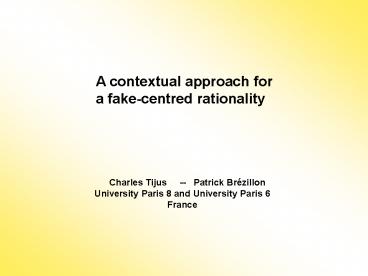Prsentation PowerPoint - PowerPoint PPT Presentation
1 / 23
Title:
Prsentation PowerPoint
Description:
their problem solving to the current context - known sources for ... formalism for task modelling. Goal. Example: Coffee preparation. UK solution. A SUBSTITUTE ... – PowerPoint PPT presentation
Number of Views:42
Avg rating:3.0/5.0
Title: Prsentation PowerPoint
1
A contextual approach for a fake-centred
rationality
Charles Tijus -- Patrick
Brézillon University Paris 8 and University Paris
6 France
2
Introduction
People adapt naturally - their problem
solving to the current context - known sources
for solving the target task --gt use of analogy or
case-based reasoning
Sometimes there is no way towards a solution,
especially when there is no known sources
3
Goal
A cognitive mechanism based on the realization
of counterfactuals to get substitutes as
sources It is the target that is adapted
according to the context for finding
sources Clarity and rationality requires a
context-based formalism for task modelling
4
Example Coffee preparation
5
Example Adaptor? Did you say adaptor?
A SUBSTITUTE
6
Example of the horse
Hi
- The hobby horse for
- mounting
- galloping
7
A hobby horse for mounting
- The impasse to fix is riding a horse
- The impasse can be solved by
- constraint relaxation (abandon the horse),
- creating unconditioned substitutes
- (anything that can be used here for
riding), - Impasses provide useful information
- about situation properties that are
- relevant to the problem.
- A stick (or a broom) can be counterfactual
8
A hobby horse for mounting
The question is not how to leave the impasse
(fact), but how would be the situation if it
was not an impasse (fake).
Analogy is not the right way for explaining
conceptual changes that accompanies building of
new solutions
9
A hobby horse for galloping
Galloping is movement
10
Problem
11
Problem
Given X, Y and Z, Find the surface of the black
part of the rectangle
X
Y
Z
12
X
Problem
Given X, Y and Z, find the surface of the black
part of the rectangle
Y
Have you an idea?
Z
13
X
Problem
Given X, Y and Z, find the surface of the black
part of the rectangle
Y
1 Have you an idea for computing? A
parallelogram 3 Do you know the
formula?
No 4 Try another assumption
Yes 5 Compute S Y
Z No 2 Give no
solution From two rectangles 6 Constitute
the broken rectangle
7 Which type of computation?
Direct computation
8 Compute S Z Y
By difference of the two
rectangles
9 Compute the surface of each rectangle
10
Compute the difference of the two surfaces
Z
14
A real-world application
- Modeling user search on a web site by
- contextual graphs and
- eye-tracking technique
15
An experiment on science museum web sites Goal
Adequacy of web sites to users demands A
website proposes a finite lattice of paths and
the user can invent for a given goal a path
within the lattice, but cannot create a
non-existent path by modifying the lattice
(i.e. the website) --gt the effective tasks are
part of the prescribed task
16
Contextual Graphs for a uniform representation
of the elements of reasoning and of contexts
17
The role of context was studied in the WebCSTI
project by linking participants' oculomotor
behavior to the context of the
task Eyes-tracking was used to determine
which areas of the homepage the user
considered and the sequence of ocular
fixations
18
(No Transcript)
19
We identified the sequence of different areas
that the user looked at during the
search Then, we inferred the different
possibilities the user considered before s/he
chose the link to be activated by clicking on
it We finally inferred the path within the
contextual graph that best modeled user
behavior
20
As a result, path P3 in the contextual graph
contains counterintuitive links
Participants supposed that the information
ticket price for the Arthurs Museum was to
be found in general information about tickets,
or in specific information about a permanent
museum activity
21
Conclusion
We propose an operational process of building
solutions through the building of
counterfactuals categories Fakes derived from
actual categories perceived as facts to find
substitutes that are integrated in known
procedures This whole process provides routes
for solution, learning and finally clarity and
more rational decision making
22
A contextual approach for a fake-centred
rationality
Charles Tijus -- Patrick
Brézillon University Paris 8 and University Paris
6 France
Patrick.Brezillon_at_lp6.fr
23
Participants had to answer a question by
navigating the site only with the
mouse Comparison of effective paths with the
theoretical optimal path (shortest path) in
terms of click number The main difference
concerns the context, i.e. the arguments that
were taken into account by the participants
when choosing one option among many other
options































